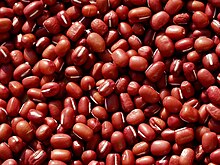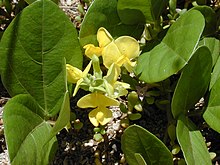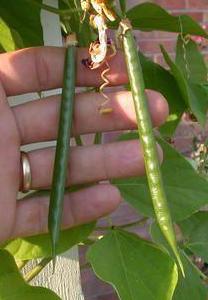Vigna
| Vigna | ||||||||||||
|---|---|---|---|---|---|---|---|---|---|---|---|---|

Subgenus Vigna Section Vigna : Vigna o-wahuensis |
||||||||||||
| Systematics | ||||||||||||
|
||||||||||||
| Scientific name | ||||||||||||
| Vigna | ||||||||||||
| Savi |
Vigna is a genus in the subfamily Schmetterlingsblütler (Faboideae) within the family of the Leguminosae (Fabaceae). There are around 100 to 150types of Vigna . It is one of the genera of the Faboideae, the species ofwhich are called beans . According to the current state of the system, a distinction is made between New World Phaseolus beans and Old World Vigna beans.
description



Vegetative characteristics
Vigna TYPES grow as creeping or climbing, rarely self-erect, annual or perennial herbaceous plants , or rarely as subshrubs to exceptionally small shrubs . They are not armed with spikes or thorns. The climbing species wind their way up counterclockwise, i.e. That is, they are "left-winding" like runner beans and fire beans - that is, the other way around as in the illustration for Vigna unguiculata . Some species develop tubers .
The alternate and spiral or two-lined leaves on the stem are arranged in a petiole and a leaf blade. The herbaceous or leathery leaf blade is usually pinnate unpaired. There are usually three (rarely two to four) to 12 cm long pinna leaflet available. The flat leaflets are entire or lobed. The two persistent or early falling stipules are free from each other and not fused with the petiole; they can be designed very differently (for example heart or shield-shaped, sometimes spurred), sometimes they are just scale-shaped.
Generative characteristics
The flowers stand individually to a few in the leaf axils or in terminal or lateral, compound racemose or umbel-like tufted inflorescences . There are bracts and bracts present, but they can fall off early.
The short-stalked, hermaphrodite flowers are zygomorphic and four or five-fold with a double flower envelope . The four or five unequal sepals are fused with two sepal lips. The upper calyx lip consists of two completely or partially fused calyx lobes; the lower calyx lip consists of three calyx lobes. The flower crowns have the typical structure of the butterfly flowers. There are five nailed petals , two or four of which are fused. The colors of the petals range from cream to yellow and from purple to purple. The wings are not spurred but eyed and in some species have two to four appendages. The flag is developed normally. The shuttle is designed very differently depending on the species. The ten fertile stamens are not fused with the petals and significantly longer ones alternate with shorter ones or they are all the same. Nine stamens have grown together to form a tube. There are nectar glands on the disc. The individual upper carpels contain three to many (100) ovules . The thread- to pencil-shaped, straight or curved stylus is hairy and bearded on one side.
The legumes are formed. Only with the Bambara peanut ( Vigna subterranea ) are the legumes in the ground, similar to the peanut ( Arachis hypogaea ). The legumes can be similar to those of peas or be “thread-shaped”. The legumes with a short stalk, at most, are 25 to 92 millimeters long, hairy or hairless, straight to curved, more or less flat to pencil-shaped, septate between the seeds and, depending on the species, externally recognizable or not constricted. Each fruit contains three to 50 seeds. The mostly kidney-shaped or square seeds can have an aril (if available then often three-pronged). The unit of dissemination ( diaspore ) is the seed.






Systematics and distribution
The genus Vigna belongs to the subtribe Phaseolinae of the tribe Phaseoleae in the subfamily Butterflies (Faboideae) within the legume family (Fabaceae).
The genus Vigna was established in 1824 by Gaetano Savi in Nuovo Giornale de Letterati , 8, p. 113. The generic name Vigna honors the Italian doctor and botanist Dominico Vigna (? - 1647), who was professor at the University of Pisa and director of the Botanical Garden from 1609 to 1632. Synonyms for Vigna Savi are: Azukia Takah. ex Ohwi , Condylostylis Piper , Dolichovigna Hayata , Haydonia R.Wilczek , Liebrechtsia De Wild. , Plectrotropis Schumach. , Scytalis E. Mey . , Voandzeia Thouars , Wajira Thulin .
The 100 to 150 types of Vigna are widespread in the Old World . The genus Vigna is named after G. Lewis et al .: Legumes of the world. (Leg World), 2005, 427 divided into seven sub-genres with around 16 sections:
- Subgenus Ceratotropis (Piper) Verdc. : Types (selection):
- Vigna aconitifolia (Jacq.) Maréchal
- Vigna angularis (Willd.) Ohwi & H.Ohashi
- Vigna glabrescens Maréchal et al.
- Vigna minima (Roxb.) Ohwi & H.Ohashi
- Vigna mungo (L.) Hepper
- Vigna radiata (L.) R. Wilczek
- Vigna reflexopilosa Hayata
- Vigna subramaniana (Babu ex Raizada) Raizada
- Vigna trilobata (L.) Verdc.
- Vigna umbellata (Thunb.) Ohwi & H.Ohashi
- Subgenus Dolichovigna : Species (selection):
- Vigna pilosa (Klein ex Willd.) Baker
- Subgenus Haydonia : Species (selection):
- Vigna monophylla deaf.
- Vigna schimperi Baker
- Vigna triphylla (R. Wilczek) Verdc .
- Subgenus Macrorhyncha
- Subgenus Plectrotropis Baker : There are two sections:
- Section Plectrotropis Verdc. : Types (selection):
- Vigna kirkii (Baker) JB Gillett
- Vigna vexillata (L.) A. Rich.
- Section Plectrotropis Verdc. : Types (selection):
- Section Pseudoliebrechtsia : Species (selection):
- Vigna lobatifolia Baker
- Section Pseudoliebrechtsia : Species (selection):
- Subgenus Sigmoidotropis : There are five sections:
- Section Caracallae (DC.) Maréchal, Mascherpa & Stainier : Species (selection):
- Vigna caracalla (L.) Verdc.
- Vigna linearis (Kunth) Maréchal et al.
- Vigna spectabilis (Standl.) A. Delgado
- Section Caracallae (DC.) Maréchal, Mascherpa & Stainier : Species (selection):
- Section Condylostylis (Piper) Maréchal, Mascherpa & Stainier
- Section Leptospron (Benth. & Hook. F.) Maréchal, Mascherpa & Stainier : Species (selection):
- Vigna adenantha (G.Mey.) Maréchal et al.
- Section Leptospron (Benth. & Hook. F.) Maréchal, Mascherpa & Stainier : Species (selection):
- Section Pedunculares Maréchal, Mascherpa & Stainier : Species (selection):
- Vigna peduncularis (Kunth) Fawc. & Rendle
- Section Pedunculares Maréchal, Mascherpa & Stainier : Species (selection):
- Section Sigmoidotropis : Species (selection):
- Vigna antillana (Urb.) Fawc. & Rendle
- Vigna elegans (Piper) Maréchal et al .
- Vigna speciosa (Kunth) Verdc.
- Section Sigmoidotropis : Species (selection):
- Subgenus Vigna Savi : There are nine sections:
- Section Catiang (DC.) Verdc. : Types (selection):
- Vigna nervosa marquets
- Vigna unguiculata (L.) Walp. : Of the eleven or so subspecies, three are useful plants.
- Section Catiang (DC.) Verdc. : Types (selection):
- Section Condylostylis (Piper) Maréchal, Mascherpa & Stainier
- Section Glossostylus : Species (selection):
- Vigna venulosa Baker
- Lasiospron section : Types (selection):
- Vigna lasiocarpa (Mart. Ex Benth.) Verdc.
- Vigna longifolia (Benth.) Verdc.
- Lasiospron section : Types (selection):
- Section Liebrechtsia : Species (selection):
- Vigna decipiens Harv.
- Vigna frutescens A. Rich.
- Section Liebrechtsia : Species (selection):
- Section Macrodontae : Species (selection):
- Vigna membranacea A. Rich.
- Section Macrodontae : Species (selection):
- Procerae section
- Section Reticulatae : Species (selection):
- Vigna reticulata Hook. f.
- Vigna wittei Baker f.
- Section Vigna Savi : Types (selection):
- Vigna ambacensis Welw. ex Baker
- Vigna angivensis Baker
- Vigna comosa Baker
- Vigna filicaulis Hepper
- Vigna gracilis (Guill. & Perr.) Hook. f.
- Vigna heterophylla A. Rich.
- Vigna hosei (Craib) Backer
- Vigna laurentii De Wild.
- Vigna luteola (Jacq.) Benth.
- Vigna marina (Burm.) Merr.
- Vigna multinervis Hutch. & Dalziel
- Vigna o-wahuensis bird
- Vigna oblongifolia A. Rich.
- Vigna parkeri Baker
- Vigna racemosa (G.Don) Hutch. & Dalziel
- Bambara peanut ( Vigna subterranea (L.) Verdc. )
- Section Vigna Savi : Types (selection):
No longer belongs to the genus Vigna :
- Vigna aristata Piper ⇒ Faselbohne ( Lablab purpureus (L.) Sweet )
use
Some species are cultivated for the production of food:
- Mat bean ( Vigna aconitifolia (Jacq.) Maréchal )
- Adzuki bean or red bean ( Vigna angularis (Willd.) Ohwi & H.Ohashi )
- Urd bean ( Vigna mungo (L.) Hepper )
- Mung bean ( Vigna radiata (L.) R. Wilczek ): " Bean sprouts "
- Bambara peanut ( Vigna subterranea (L.) Verdc. )
- Rice Bean ( Vigna umbellata (Thunb.) Ohwi & H.Ohashi )
-
Vigna unguiculata (L.) Walp. : Three subspecies are used by it:
- Catjang bean ( Vigna unguiculata subsp. Cylindrica (L.) Van Eselt. )
- Asparagus Without ( Vigna unguiculata subsp. Sesquipedalis (L.) Verdc. )
- Cowpea ( Vigna unguiculata (L.) Walp. Subsp. Unguiculata )
- Vigna vexillata (L.) A. Rich. : (no German name)
Since they fix nitrogen ( Rhizobium root nodules ), they are important for soil improvement.
See also
swell
- SI Ali: Papilionaceae in the Flora of Pakistan : Vigna - Online.
- Leslie Watson: Papilionaceae in the Western Australian Flora , 2008: Vigna - Online.
Individual evidence
- ↑ a b c Vigna in the Germplasm Resources Information Network (GRIN), USDA , ARS , National Genetic Resources Program. National Germplasm Resources Laboratory, Beltsville, Maryland.
- ↑ Lotte Burkhardt: Directory of eponymous plant names. Botanic Garden and Botanical Museum Berlin, Free University Berlin Berlin 2016. ISBN 978-3-946292-10-4 , doi : 10.3372 / epolist2016
Web links
- Walter H. Schuster: Legumes for grain use : Joachim Alkämper: Information on the genus Vigna . (German)
- Vigna on the Germplasm Resources Information Network (GRIN), USDA , ARS , National Genetic Resources Program. National Germplasm Resources Laboratory, Beltsville, Maryland.
- Names in the genus Vigna .

